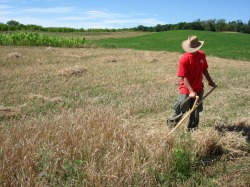 I met Martin at my 2008 Spring Scythe Workshop. Martin had been growing grains in his home garden plots for a number of years, and he wanted to expand to growing and harvesting grains by hand on a larger scale. He had contacted Peter Vido to find out how to harvest grain with a scythe. Peter Vido recommended that he attend one of my scythe workshops. If you can, it's best to learn how to use a scythe at a workshop. It shortens your learning curve considerably. After the workshop, Martin and I hatched a plan to hold a scythe workshop/experiment at his farm, when he had a grain crop ready to harvest. He would get help harvesting his crop, the workshop participants would provide the labor in exchange for the learning opportunity, and I could gain knowledge and sell scythes. A win-win-win situation. What could go wrong? 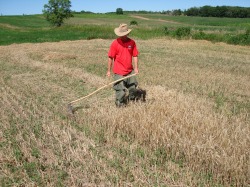 So Martin had an acre of barley planted on his father's farm, for us to experiment with. His father owned a huge tract of farmland as investment property, and rented it out to local farmers. Martin lived nearby, and supervised it. He had the farmers plant an acre of a barley known as Conlon, which is a two-row malting barley popular with home brewers. (It's available in 50 lb bags from Albert Lea Seed of MN. They're a very affordable source for common types of organic small grains for, and they will gladly do mail orders for small scale buyers.). The barley did well. Martin and the farmer estimated when it would be ready to harvest. We set up a workshop date, and I got people to sign up for it. Then the weather turned very hot and dry, and the barley suddenly ripened up two weeks early. Martin phoned me and told me that he had to have his farmer quick harvest the field with a combine, otherwise the grain would have been so ripe, it would have just fallen off the stalk. He had the farmer save a 6 foot wide strip down the length of his field, for us to experiment with, though. So I canceled the workshop, and loaded my van with all the different types of blades and snaths that I wanted to try out on grains, and drove out to Martin's farm to see what we could salvage for an experiment. It turns out that we learned a lot. 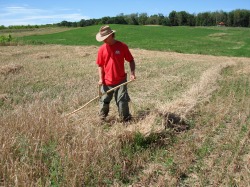 The first thing that I wanted to experiment with was how best to cut the grain, so that it could be gathered into sheaves, for easier threshing. I didn't have any grain-cradles, and had even heard from Kai Vido, that they don't work very well anyway, and a good mower could mow neatly enough so that all the heads line up in the same direction. When I mow mature timothy grass, the heads certainly do all line up in the swath, so I thought it might be possible. Well it turned out that because the barley had ripened so early, it was extremely short. No matter what we did, it made mowing the grain so that the heads were all lined up in the same direction, impossible. And there actually didn't seem to be a point to it. Usually you want the grain heads all lined up so that when you thresh the sheave, you only have to beat the end of the sheave with the grain head. Otherwise you would have to beat the whole length of the long stalk, if the straw was all jumbled up in a big pile. But since the stalks were so short, we decided it would be a lot less work overall to thresh a little more, instead of bundling the stalks into sheaves first. Grains are very easy to mow with a sharp Austrian scythe. It practically jumps out of the way, when it sees the scythe blade coming. It's so easy to mow, even an American scythe can cut it. The hardest part is keeping all the grain-heads pointing in the same direction in the swath. Since we didn't have to fuss with that, we could just mow all out, and enjoy it. The two of us quickly mowed the one strip of barley. I started at one end, and Martin at the other. We met in the middle, and then we gently raked up the barley stalks with hayrakes, and loaded it onto the back of his pick-up truck. Then we headed back to his garage, to try threshing it. 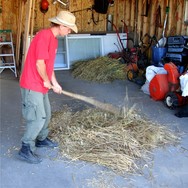 At his garage, Martin demonstrated how he threshes grain on the cement floor, with a home-made flail. A flail is basically a long light stick, and a shorter heavier stick, with holes drilled through cross-wise at the ends, and a leather strap tying them together. Rawhide works best, he informed me. Everything else wears out too quick, and then the beater can suddenly go flying. The barley was so dry and ripe, it threshed very easily. This got me thinking. 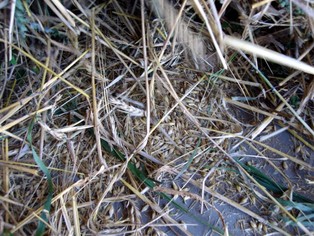 Conlon Barley Conlon Barley Having a very short variety of grain, made it less necessary to bundle the grain into sheaves for threshing. A sharp Austrian scythe mowed the grain so quickly and easily, that the ripe grains didn't fall off. A heavy American scythe would have given the grain stalks a good shake while cutting, which would have made the ripe grain more likely to fall off. Skipping the bundling into sheaves part, saved a lot of labor. What if you could grow very short varieties of easy-to-thresh grain, for human consumption, and just skip the bundling into sheaves part altogether? Or,..what if you grew short varieties of harder to thresh grain, for poultry feed, and skipped the threshing all together? What if you just stored the grain stalks like hay, and fed it to your geese, turkeys or chickens, as scratch grain? It would give them something natural to do during the long, cold, and boring winters that we have here. Are there hulless varieties of grains, with very short stalks that could be grown for these purposes? 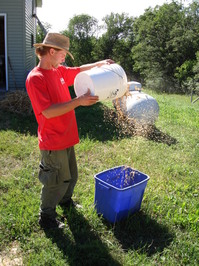 Next, before I had to leave, Martin quick showed me how he winnows his homegrown grains. He wasn't done threshing the first pile of barley, but he had some threshed hulless oats on hand, that he had grown in his garden. He had been waiting for a day with a steady breeze. The wind was a little sporadic, but he showed me anyway. He slowly pours the grain between two 5 gallon buckets, while the wind blew away the lighter chaff from the heavier falling grain. A slow and steady hand was required. It wasn't the best day for it, but I got the idea. Driving home, I reflected on all I had learned, and once again realized that I had even more questions than before. One of them was, " Why did grains have to be harvested early, and ripened in the field in sheaves, in the old days?" With modern combines, they don't do that. They harvest when the grain is ripe.
7 Comments
5/22/2011 03:21:46 am
HI there - great site, and thank you so much for all the information! We have just started our scything! It's my understanding that the grains were cut early so that they would not only dry on the stalk but also ferment - people had a better understanding that grains have "anti-nutrients" in them, and are much easier digested by the human body if they have had a chance to ferment a bit before they were consumed - like "sprouted " wheat now, once again, popular!
Reply
graham anderson
5/4/2012 04:50:31 pm
Nope. Grains do not ferment unlesd they are very wet. Think about what you're saying: that every new barley plant began its life as a partially fermented grain! Grains do not normally ferment on the stalk.
Reply
El_Gordo
5/19/2014 10:13:33 pm
Grains dry in the field in bundles so that they aren't stored wet. There's a lot of moisture in the stalk.
Reply
Botan Anderson
5/22/2011 10:40:07 am
Since some of the grain that was harvested had to be used as seed for future crops, I don't think that the grain would be left out to ferment. The "anti-nutrients" protect the seed from degradation and untimely sprouting. You would want seed to remain viable as long as possible, and at the same time, dormant until it's planted.
Reply
Sean
7/28/2012 03:26:44 pm
Could it be that they wanted to leave time for the weeds that would have inevitably been interspersed with the grain (these were days before roundup of course) to cure as well, adding nutritional value if the sheaves were to be used as livestock feed or preventing the green foliage from causing spoilage in the time between harvest and threshing?
Reply
Botan Anderson
7/29/2012 02:36:43 am
To let the green weeds dry is one of the main reasons that they used to let the sheaves sit out in the fields and dry, according to the man that grows the grains for my duck and goose feed. The grain straw was not used as feed. It was used as bedding. However, when I look at old films of grain harvests, back before they had Round-Up, I don't see any weeds.
Reply
jim
11/25/2014 09:50:29 pm
Very helpful site and comments. We jabbed a small multi discipline organic farm. I would like to Harvey by hand some barley hay for stock feed. So I am at the moment not directing my mind to threshing but hand cutting and baling. Assuming the hay is cut with a scythe and falls to one side is there an efficient way to gather and tie it for storage or are sheaths the best method? Thanks Jim
Reply
Your comment will be posted after it is approved.
Leave a Reply. |
Botan AndersonArchives
March 2023
Categories
All
|

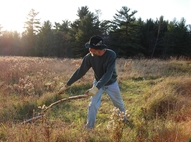
 RSS Feed
RSS Feed